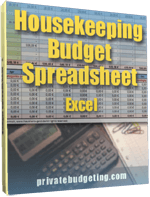How to create a budget?
It’s easier than ever to get stuck in the habit of overspending, especially with zero-percent financing and the ever-present opportunity to conveniently pay with credit cards or eWallets, online as well as in brick and mortar stores. This not only applies to larger acquisitions; low-priced consumer and convenience goods are no longer exceptions either. Without a nest egg or budget, a speedy repayment of consequent potentially financial liabilities can be difficult, though. In fact, budgeting the right way and overspending are mutually exclusive. This guide to creating and maintaining your personal spending plan can help you on your way to a healthy spending habit.
Note: Proper money management is not about how much money you make but what you do with what you've got. Healthy budgeting does not involve some sort of magic formula to make more money; it means getting the most out of the money you do have, no matter how much that might be.
1. Budgeting - the foundation of sound money management
Creating and maintaining a budget is an important aspect of sound money management. Budgeting is the process of monitoring and adjusting spending habits over a specific period of time. Creating this spending plan allows you to balance your expenses with your income and determine how to best spend your money. If you spend more money than you make, you increase the risk of slowly sinking deeper into debt. If you break even at the end of the month or better yet, you have money left, you are well on your way to your financial goals. Either way, you can use budgeting to prioritize your spending and focus on the things that are most important to you.2. How to create a budget?
If you want to create a budget, you won't be able to avoid documenting all your expenses and earnings. Compared to variable expenses and earnings, fixed expenses and earnings are more consistent over a certain period of time and therefore often constitute the backbone of a budget. For this reason, identifying and documenting your overhead costs and regular income should be the first step in creating a budget; that's half the battle.2.1. Calculate fixed earnings and expenses.
- Assess your regular monthly expenses:
Take note of any recurring monthly expenditures, such as house or rent payment, insurance premium, car payment, savings, minimum payments on debts, and utilities. Expenses that stay the same every month might also be money that you regularly spend on fun things, e.g. eating out, entertainment, or hobbies. - Sum up your regular monthly earnings:
Calculate how much money you can expect with certainty each month after taxes and other payroll deductions. Only document income that you can rely on to be available regularly, e.g. a monthly salary. - Substract monthly expenses from earnings:
The balance of your fixed monthly expenses and earnings is the amount of money that you can expect to have left after covering all of your regular monthly expenses. This balance can bei either negative (not so good) or positive (good).
2.2. Calculate variable earnings and expenses.
Finally, to flesh out the aforementioned backbone of your budget you need to make note of any extra expenses that you think might occur for the upcoming month. Alternatively, you can also take note of your expenses as they occur, e.g. by collecting receipts and updating your budget accordingly to see where it takes you at the end of the month.2.3. Calculate total balance of your overall expenses and earnings.
-
Substract any extra expenses:
Extra expenses might include clothing, scheduled car or home repairs, leisure activities, medical or dental bills, gifts, and holiday-related purchases. Deduct any extra expenses from the balance of your fixed monthly expenses and earnings (the figure that you arrived at in the last step above) to get what you will have left at the end of the month in total.
2.4. Build a cushion and invest in yourself.
-
Build in a cushion:
Look at how much money you expect to keep or to have left after covering all of your calculated expenses, and decide if that money is enough to cover unexpected expenses; a financial bolster of 10 percent each month is a good rule-of-thumb. -
Evaluate your budget:
If your budget comes out on the negative side, check your regular monthly expenses again for places to make cuts; keep doing this until your budget works. - Invest in yourself:
If you find you have money left, consider using some or all of it to pay off debts or add to a savings account or investment portfolios.

